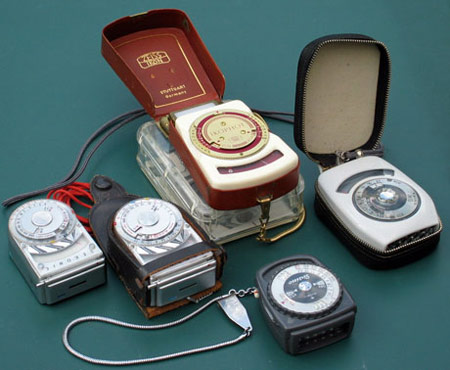
A pile of exposure meters
I have tried to concentrate on collecting only cameras but as a bonus I have received some separate exposure meters.They all are match needle type with a selenium light sensor. Selenium exposure meter don´t need a battery. Selenium cell produces electrcity when exposed to light. That is the idea of a selenium exposure meter.
I made some inquiries using books and know-it-all Google and got these answers:
Selenium : Symbol Se A nonmetallic element, red in powder form, black in vitreous form, and metallic gray in crystalline form, resembling sulfur and obtained primarily as a byproduct of electrolytic copper refining. It is widely used in rectifiers, as a semiconductor, and in xerography. Its photovoltaic and photoconductive actions make it useful in photocells, photographic exposure meters, and solar cells. Atomic number 34; atomic weight 78.96; melting point (of gray selenium) 217°C; boiling point (gray) 684.9°C; specific gravity (gray) 4.79; (vitreous) 4.28; valence 2, 4, or 6.s discovered by the Berzelius in 1817 (
Berzelius , Jöns (1779-1848), Swedish researcher who is known as the father of chemistry.) , and in 1873 Smith found that the resistivity of selenium was a function of the intensity of the illumination falling on the surface of the material. What is then a photocell? It is a photoelectric cell that uses a strip of selenium. Selenium photocells are commonly used in photographic-exposure meters, burglar alarms, etc. ... Exposure meter: The photographer's tool for measuring light. A properly-exposed film will produce an image that correctly
reproduces the subject in true-to-life tones and colors. The etymological background of the noun Selenium comes from the Greek word selas which means brightnes, light.
